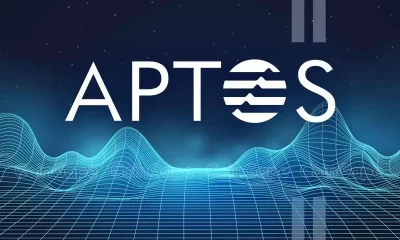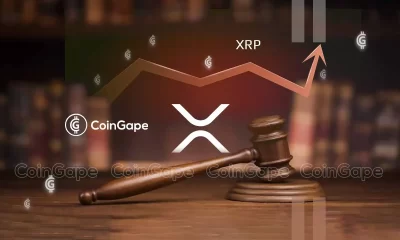Markets
Polymarket Retains Loyal User Base a Month After Election, Data Shows
Published
4 months agoon
By
admin
During the dog days of summer, Polymarket’s election betting surged on (correct) speculation that the Democrats would make a “hot swap” of Joe Biden for Kamala Harris as their presidential candidate. Trading volume grew and grew through the fall. All along, doubts lingered about whether the platform’s trader base would hold steady after the ballots were cast.
On Election Day, the research arm of gaming and VC giant Animoca put out a report with a bold prediction: there’s nothing for Polymarket to worry about. The crypto-based prediction market, according to the report, had a significant base of non-election bettors to carry it through.
Naturally, there would be smaller numbers – what can be as captivating as a political face-off involving Donald Trump? – but it’d be a far cry from a ghost town. Three-quarters of Polymarket users, Animoca noted, trade contracts unrelated to the election.
A month later, that analysis is looking right.
A key data point to track is the open interest on Polymarket. Open interest, which is the total value of active positions in Polymarket’s prediction markets, reflects the platform’s liquidity, user activity, and overall market engagement.

Data from a Dune Analytics dashboard shows that while open interest hit peaked just above $475 million on Election Day – and, predictably, significantly declined in the days after – it has been ticking back up in the last week.
The data shows open interest dropped to a low of $93.91 million on November 12, then slowly climbed to $104 million by November 15 and further to $115.25 million by November 30. These aren’t bad numbers for Polymarket by any means, because this is where open interest was in mid-September, when election fever was in full swing.
Similarly, daily volumes, while down sharply from their $367 million peak the day after the election, have plateaued in the mid- to high eight figure range, which is still higher than they were in September.
The next metric to look at is the number of active wallets on the platform.

In the last week, this metric – which reflects the number of traders active on the platform – has been hovering around the mid-30,000 mark, which isn’t substantially lower than the weeklong run-up to election day, when there were an average of 39,100 active wallets at work.
And is Polymarket reliant on a few whales to drive volume? Not really.

Data shows that around 60% of all bets are coming in under $100, and only 5.8% of bets are between $1,000 and $5,000.
Polymarket is here to stay, but dark clouds remain. It needs to work through its legal issues, which may soon be resolved if President-elect Trump installs a crypto-friendly financial regulatory regime.
Influencer Mea Culpa
A social media influencer involved in a Kalshi plot to bash Polymarket and its founder, Shayne Coplan, has apologized for a post in which he called Coplan the “n-word” and said he “look[ed] guilty.”
… @PirateWires @shayne_coplan I posted something sent by the Kalshi team about the Polymarket creator… I didn’t do research on it & honestly didn’t even know what I was posting when I posted it. I was doing other business with Kalshi and just tweeted it…. I want to say sry…
— AB (@AB84) November 30, 2024
“I was doing other business with Kalshi and just tweeted it,” Antonio Brown wrote on X (formerly Twitter) Saturday. “I want to say sry to Shayne Coplan.”
Earlier, Clown World, an influencer account that regularly tweets Kalshi-related content, deleted a post calling Coplan and convicted fraudster Sam Bankman-Fried lookalikes.
Kalshi’s CEO, Tarek Mansour, has previously declined to comment on the record.
Markets Missed Biden Pardon
Hunter Biden, the wayward son of President Joe Biden, was pardoned Sunday, a move that surprised many – including traders on Polymarket.
The pardon covers all offenses committed in a ten-year period between January 1, 2014, and December 1 of this year, a statement from the White House reads. This covers Hunter’s tax and gun charges – in addition to any undetected crimes.
Before the pardon announcement, contracts representing the yes side of the question were trading around 28 to 30 cents, reflecting a 28% to 30% chance a pardon would happen. Now that the White House has confirmed the executive grant of clemency, these contracts shot up to 100%, which means they will pay out 1 USDC, each worth $1, per share.
The market was skeptical a pardon would happen, given multiple pledges by the President that it would not.
In June, the elder Biden promised to respect a jury decision regarding a gun charge and not pardon his son. At the time, the market was giving a 12% chance of a pardon.
Data aggregator Polymarket Analytics shows that the top holder of the yes side, a user who goes by “PollsR4Dummies” took home $223,472 on his bet of $87,740.
The polling skeptic is also holding two long-shot yes positions, betting that Fox News personality Pete Hegseth will be confirmed as Secretary of Defense, currently at 32% given recent sexual assault allegations, and that the Fed will cut interest rates three times in 2024 (the market gives this a 29% chance).
Source link
You may like


Bitcoin Trades Above $79K as Asia Markets React to Trump Tariffs


Memecoin platform Pump.fun brings livestream feature back to 5% of users


Bitcoin Price On The Verge Of Explosive 15% Breakout As Analyst Spots Triangle Formation


Strategy CEO Makes The Case For Corporate Bitcoin Adoption In MIT Keynote


Hackers Hammer Android and iPhone Users As Bank Account Attacks Surge 258% in One Year: Kaspersky


Cryptocurrencies to watch this week: Aptos, XRP, Solana
BTC
Bitcoin Trades Above $79K as Asia Markets React to Trump Tariffs
Published
53 minutes agoon
April 7, 2025By
admin
Bitcoin (BTC) traded above $79,000 Monday morning Asia time as markets around East Asia opened to chaos and carnage as the global sell-off continued.
The CoinDesk 20 (CD20), a measure of the performance of the largest digital assets, is down 8%.

Hong Kong’s Hang Seng Index is down over 8% during mid-morning trading, while Shanghai’s SSE Composite Index is down 7%, and the Taipei’s TAIEX is down 9%.
Major tech stocks across the region were some of the hardest hit. Alibaba shares in Hong Kong were down 12% while Tencent was down 9%. In Taipei, TSMC stocks dipped 10% in the first few minutes of trading, triggering the exchange’s price variation limit mechanism which halts trading in either direction.
TSMC’s correction comes as the White House says that semiconductors from Taiwan are exempt from tariffs, but the future of the CHIPS Act – which bankrolled the construction of semiconductor factories in the U.S. – is in question.
TSMC’s major correction on market open is likely foreshadowing of Nvidia’s open in the U.S. Some analysts say NVDA has become more volatile than BTC or ETH.
Elsewhere in crypto, Ethereum (ETH) is down 11% on-day, XRP is down 9%, and Solana’s SOL is down 10%.
Lending protocols Maker (MKR) and Aave (AAVE) were some of the worst performers on the market, down around 14% each.
Liquidation data from CoinGlass shows that in the last 12 hours around $675 million in long positions have been liquidated, compared to $123 million in shorts.
TRUMP, the Presidential meme coin, is down 13% according on CoinDesk data, putting it behind lending protocol majors as one of the market laggards.
Source link
Aptos
Cryptocurrencies to watch this week: Aptos, XRP, Solana
Published
5 hours agoon
April 6, 2025By
admin
Cryptocurrency prices were mixed last week after President Donald Trump announced his reciprocal tariffs and Federal Reserve Chairman Jerome Powell warned about stagflation.
Bitcoin (BTC) hovered between $82,000 and $85,000, while the market cap of all coins dropped slightly to $2.65 trillion. Some of the top cryptocurrencies to watch this week will be Aptos (APT), Ripple (XRP), and Solana (SOL).
Aptos

Aptos’s price has been in a strong downtrend this year, dropping from November’s high of $15.32 to $4.70. This decline happened because of the ongoing crypto crash and its token unlocks, leading to substantial dilution.
Aptos has a circulating supply of 604 million against its total supply of 1.14 billion, with 11.3 million tokens being unlocked each month. The next unlock will happen on Saturday, when tokens worth $52 million will be allocated to the community, core contributors, investors, and the foundation.
These unlocks come as the Aptos price hovers at an important support level. It has resisted moving below the current range at least four times since July last year. Therefore, a volume-supported drop below the current level will point to more downside, potentially below $4. The bearish view will become invalid if the coin rises above the 50-day moving average at $5.80.
XRP

XRP is another cryptocurrency to watch next week for technical reasons. The chart above shows that the coin traded at $2.10 on Sunday, a few points above the crucial support level at $1.9325. This is a notable level since it is the neckline of the head and shoulders pattern, whose head is at $3.4 and the shoulders are at $3.
$1.9325 also coincides with the 50% Fibonacci Retracement level. Therefore, a drop below that level will confirm the bearish view of the H&S pattern and point to further downside, initially to $1.5370, the 61.8% retracement level. This target is about 26% below the current level.
Solana

Solana, the popular layer-1 network, will also be one of the top cryptocurrencies to watch this week. Traders will focus on it because it has reached a crucial support level of $115, its lowest point in March.
Solana is forming a small double-bottom pattern with a neckline at $147.18. This is an important bullish reversal sign. SOL has failed to move below this level several times since last year.
Therefore, a move below that support level will point to more downside, potentially to the support at $100.
Source link
Bitcoin
Bitcoin (BTC) Price Posts Worst Q1 in a Decade, Raising Questions About Where the Cycle Stands
Published
9 hours agoon
April 6, 2025By
admin
Bitcoin just notched its worst first quarter in a decade, falling 11.7% as markets struggled to understand the new administration’s economic agenda.
The performance ranked 12th out of the past 15 first quarters, according to NYDIG Research’s data.
The drawdown invites a familiar question in crypto circles: is the cycle over? The last time bitcoin started the year this poorly was in 2015, during a prolonged slump following the 2013 peak and after the collapse of Mt. Gox, according to NYDIG. Back then, prices recovered modestly over the rest of the year before surging in 2016.

In the first quarter of 2020, amid a market sell-off tied to fears surrounding the COVID-19 pandemic, BTC saw a 9.4% drawdown but then recovered to end the year up over 300%. In other years with negative Q1 returns—like 2014, 2018 and 2022—bitcoin ended the year down sharply, coinciding with the tail ends of previous bull cycles, the research note said.
This time around, the backdrop is murky. Cryptocurrency prices surged after Donald Trump won the U.S. election in November after running a pro-crypto campaign. While under the Trump administration, the sector has been gaining greater regulatory clarity, and the U.S. Securities and Exchange Commission (SEC) backed off a number of lawsuits against crypto firms, it isn’t all bullish.
Trump unveiled his reciprocal tariffs against nearly every country in the world last week, leading to a massive $5.4 trillion U.S. equities market wipeout in just two days. This led to the S&P 500 index’s lowest level in 11 months and the Nasdaq 100’s entry into bear market territory. While bitcoin has outperformed so far, what will happen after Monday’s opening bell is unclear.
Historically, a weak Q1 doesn’t always spell doom for BTC, NYDIG’s data shows. The asset has bounced back in half of the years when it started in the red. The recent macroeconomic backdrop has seen analysts raise recession odds, which could test BTC’s role as a “U.S. isolation hedge.”
Read more: Chart of The Week: Will April Bring Good Luck or Fool’s Hope for Bitcoin?
Source link

Bitcoin Trades Above $79K as Asia Markets React to Trump Tariffs

Memecoin platform Pump.fun brings livestream feature back to 5% of users

Bitcoin Price On The Verge Of Explosive 15% Breakout As Analyst Spots Triangle Formation

Strategy CEO Makes The Case For Corporate Bitcoin Adoption In MIT Keynote

Hackers Hammer Android and iPhone Users As Bank Account Attacks Surge 258% in One Year: Kaspersky

Cryptocurrencies to watch this week: Aptos, XRP, Solana

This Week in Crypto Games: ‘Off the Grid’ Token Live, Logan Paul ‘CryptoZoo’ Lawsuit Continues

Crypto Liquidations hit $600M as BTC Plunges Below $80K First Time in 25-days

Bitcoin (BTC) Price Posts Worst Q1 in a Decade, Raising Questions About Where the Cycle Stands

Stablecoins are the best way to ensure US dollar dominance — Web3 CEO

Chainlink (LINK) Targets Rebound To $19 — But Only If This Key Support Holds

NFT industry in trouble as activity slows, market collapses

US Tech Sector About To Witness ‘Economic Armageddon’ Amid Trump’s Tariffs, According to Wealth Management Exec

XRP’s Open Interest Surges Above $3 Billion, Will Price Follow?

This Week in Bitcoin: BTC Holds Steady as Trump’s Trade War Wrecks Stocks

Arthur Hayes, Murad’s Prediction For Meme Coins, AI & DeFi Coins For 2025

Expert Sees Bitcoin Dipping To $50K While Bullish Signs Persist

Aptos Leverages Chainlink To Enhance Scalability and Data Access

Bitcoin Could Rally to $80,000 on the Eve of US Elections

Sonic Now ‘Golden Standard’ of Layer-2s After Scaling Transactions to 16,000+ per Second, Says Andre Cronje

Institutional Investors Go All In on Crypto as 57% Plan to Boost Allocations as Bull Run Heats Up, Sygnum Survey Reveals

Crypto’s Big Trump Gamble Is Risky

Ripple-SEC Case Ends, But These 3 Rivals Could Jump 500x

Has The Bitcoin Price Already Peaked?

A16z-backed Espresso announces mainnet launch of core product

Xmas Altcoin Rally Insights by BNM Agent I

Blockchain groups challenge new broker reporting rule

The Future of Bitcoin: Scaling, Institutional Adoption, and Strategic Reserves with Rich Rines

Trump’s Coin Is About As Revolutionary As OneCoin

I’m Grateful for Trump’s Embrace of Bitcoin
Trending

 24/7 Cryptocurrency News5 months ago
24/7 Cryptocurrency News5 months agoArthur Hayes, Murad’s Prediction For Meme Coins, AI & DeFi Coins For 2025

 Bitcoin3 months ago
Bitcoin3 months agoExpert Sees Bitcoin Dipping To $50K While Bullish Signs Persist

 24/7 Cryptocurrency News3 months ago
24/7 Cryptocurrency News3 months agoAptos Leverages Chainlink To Enhance Scalability and Data Access

 Bitcoin5 months ago
Bitcoin5 months agoBitcoin Could Rally to $80,000 on the Eve of US Elections

 Altcoins2 months ago
Altcoins2 months agoSonic Now ‘Golden Standard’ of Layer-2s After Scaling Transactions to 16,000+ per Second, Says Andre Cronje

 Bitcoin5 months ago
Bitcoin5 months agoInstitutional Investors Go All In on Crypto as 57% Plan to Boost Allocations as Bull Run Heats Up, Sygnum Survey Reveals

 Opinion5 months ago
Opinion5 months agoCrypto’s Big Trump Gamble Is Risky

 Price analysis5 months ago
Price analysis5 months agoRipple-SEC Case Ends, But These 3 Rivals Could Jump 500x


